#ww1 dress
Explore tagged Tumblr posts
Text

Les Modes, 1917
#Les Modes#1917#1910s#Fashion history#Historical fashion#Historical clothing#Dress history#Vintage dress#Vintage fashion#Antique dress#Antique fashion#Antique clothing#Corset#Costuming#Costumes#Costume design#20th century#20th century art#20th century dress#20th century fashion#Turn of the century#fashion#black dress#black velvet#ww1#world war 1#ww1 dress#ww1 fashion#Lucile#Lucy Duff Gordon
377 notes
·
View notes
Text
Kerstin Evening Dress

A fashionable dress suitable for wild nights out and weddings alike, named after the most glamorous woman of all: my dog. Sort of inspired by a dress from Downton Abbey, but not really. Thanks to @mrtri91 for inspiring me to make it in the first place.
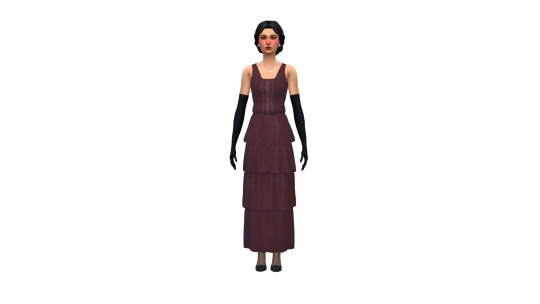
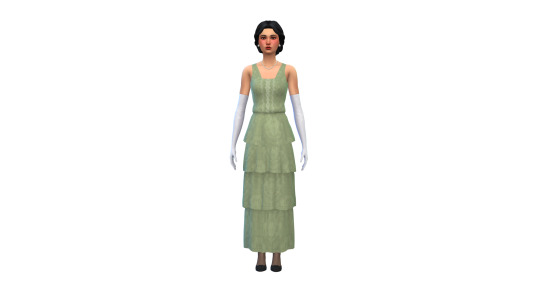
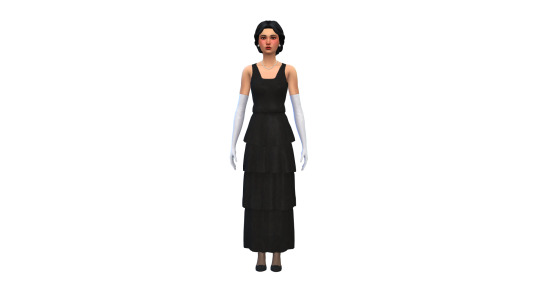

BGC
Custom thumbnail
15 swatches
Tagged as feminine
Found in the Long Dresses category
Formal, Party
Polycount: 6168
All LODs
Normal + specular map
Color tagged
Display index by decade
Disabled for random
Download (SFS)
Alt Download (Mediafire)
#my cc#ts4 1910s#ts4 1920s#(it's intended for about 1918/1919 but works well as an early 20s dress too)#20c#sims 4 historical#sims 4 cc#sims 4 custom content#ts4cc#historical cc#sims 4#the sims 4#ts4#af cc#ts4 cc#ts4 historical#fullbody#ts4 ww1#ts4 interwar
251 notes
·
View notes
Text
I have just discovered the German artist Arthur Thiele (1860-1936). He created many postcard designs, and a lot of his work has a comic or sentimental turn. I'm really enjoying his First World War postcards.

“Wir Barbaren, Heimkehr vom Felde” (We Barbarians, Homecoming from the Field), postmarked 1917.

“Auf Urlaub” (On Leave), postmarked 8 July 1916.

Submarine "U 9" in battle with the English cruisers Hogue, Abukir, and Cressy, 1915.


Im Nachtlager: machine translated as "In the night camp." A really classic scene of soldiers in fatigue caps bedding down in straw that could be from the Napoleonic era. All images from Thiele's Wikimedia Commons gallery.
#first world war#wwi#great war#1910s#military history#postcards#arthur thiele#ww1#u boat#dressed to kill#i do love that soft cap they have (kratzchen cap?)#thiele has some Wacky Trench Scenes in his oeuvre#and it also makes me feel sad to think of a german soldier sending some of these upbeat postcards in 1917
38 notes
·
View notes
Text
Also for the record, the whole White Witch-enchanted food thing still would have worked regardless of when the story was set. Kids like sweets, especially magic ones that symbolize temptation. The WW2 sugar rationing is not the pivotal element here
#the ww2 aspect of narnia is interesting flavor but like. it's not really essential#lots of books are inextricably linked to their historical contexts such that they can't be properly understood without them#i honestly don't think lww is one of them#the turn of the century setting of mn is far far more important to the story proper than ww2 is for lww#bc of the role it plays in genre and the influence of lewis's childhood on the story#the evacuation of london has one (1) essential story function: it gets the kids into a strange country house and away from their parents#you'll notice it gets dropped entirely in subsequent books#it's very interesting set dressing and definitely cool to play with#but narnia is not at its heart a ww2 story#if anything it's a ww1 story#narnia#idk why but I'm feeling very salty today
54 notes
·
View notes
Text


A Dutch and a Deutsch. Here Prussian Officer Major Isenstein is chatting up a Flemish girl. He's an energetic and flirtatious character. -Concept art for Moth.
#wwi#ww1 fiction#ottoway#moth#ww1#original comic#german#my art#prussian#flemmish#dutch#deutsch#illustration#rural#windmill#Siegfried Isenstein#Major Isenstein#windy day#evening#european#folk dress#military uniform#history#peasant#officer#jackboots#line art#coloured art#Siegfried and Celandine#wooden clogs
26 notes
·
View notes
Text
alex prakken and jeremy jordan la dee dah with you is something that will never leave my mind btw
#newsies#and only tea#alex was such a good nick given the material#book accurate? no. but trust he made it work..#and jeremy jordan is just jeremy jordan he could do whatever and id say that was great#but seeing my newsies dressed as little soldiers..#hows that for everyones ‘the newsies would fight in ww1’#the great gatsby broadway
16 notes
·
View notes
Text
So... I've noticed a severe lack of wartime Watson fanart (I might be wrong tho)
Either way, I decided to do something about it :)
Just one teeny problem, I have absolutely no idea of how the uniforms were during the Second Anglo-Afghan War. So you get WW1 AU Watson instead.
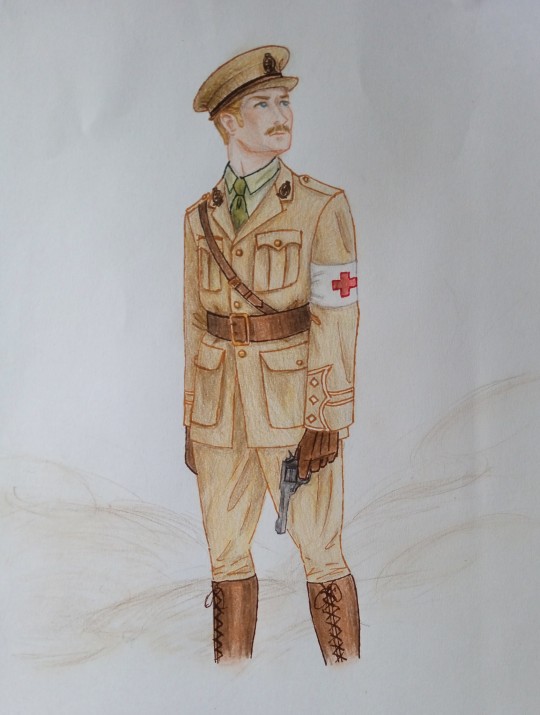
In arduis fidelis.
#ohh the are so many inaccuracies in this i can feel it#it's my first time drawing a military uniform pls don't kill me#also yeah he's left-handed now because it fit the composition better#granada holmes#john watson#doctor watson#captain watson#soldier watson#but its WW1 AU#ramc#david burke#fanart#my “art”#if you like this i might draw him in a mess dress because i live for this teehee
96 notes
·
View notes
Text
Summer's day at Zoppot
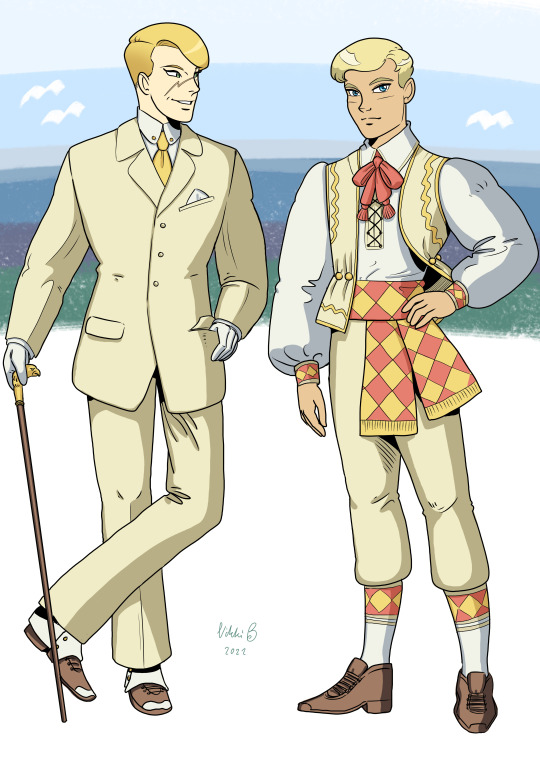
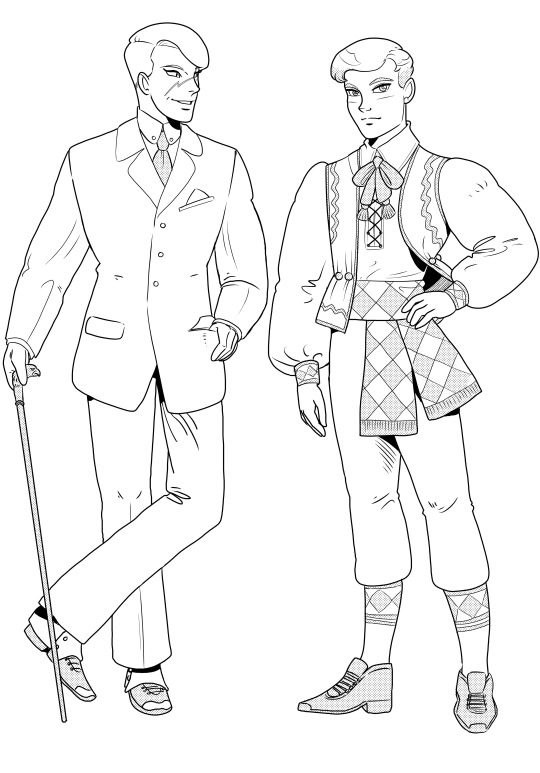
Outfits I designed for Siegfried and Peter's summer trip to Zoppot, an East Prussian Seaside Resort town, which is Sopot, Poland today.
Siegfried has a lot of flamboyant, self-conscious, tailored suits, while Peter dresses in German-Baltic folk style. to reflect his interest in the peasant revolts, and lack of care for how others might judge him. Here is an excerpt from the script wip.

#ww1 fiction#original comic#moth#oc#german#my art#psychological scarring#physical scars#seaside#summer holiday#1912#1914#zoppot#east prussia#sopot#poland#baltic folk dress#tailored suit#costume design#siegfried isentein#peter odinkirk#character designs#scriptwriting#class differences#1910's#edwardian#wilhelmian#second Reich
4 notes
·
View notes
Note
i can't believe you. i can't believe you did this to me.
Luise was trying to organize porters in the chaos of the old house, and Resi was smack in the middle of it, asking stupid questions. Turning halfway to her older sister, she gave a bored glance. "I don't have control of everything," she pointed out as she wrapped a small statue in newspaper.
"And why do you care so much? It's not like you won't be able to keep your Catholic ways, keep going to mass as you please"
10 notes
·
View notes
Text

She turned off reblogs so imma address it here.
NOT EVERYONE IS WHITE/WESTERN
YOU DUMBASS
When you mean 'socially acceptable', what you actually mean is
'normalised in western culture',
And that, was because of the 19th century dress reform movement. Also, overwhelmingly because it was a tool of feminist rebellion. Women were arrested en-masse, for wearing trousers in WW1, and yet they continued to do so, the clothing becoming an increasing point of protest, because before then, 'feminine' clothing, was extremely long skirt which were an actual danger to the female factory workers who were legally obligated to wear them.
The reason a similar movement did not be made for men, is because the male standard clothes were practical and not a legitimate physical danger. So the average man did not feel the need to protest these restrictions.
In fact men did not start using skirts/'feminine clothing' as a tool of rebellion en masse till the LGBT Rights movement.
On the other hand, feminine clothing has been GLOBALLY used as a TOOL OF OPPRESSION.
The modern day western world is one of the only places in World History, for perhaps all of human history, where men's clothing is more greatly monitored then women's. `
I will not mention the country where I am originally from because I feel like I've already said waaaaaay too much about myself online, and i'm paranoid.
But women and those AFAB are currently being shot dead in the streets of my country by morality police for- Not even wearing men's clothing- but just simply wearing SLIGHTLY TOO 'MASCULINE' (practical) CLOTHES.
So don't sit there in your fucking privilege and talk about how femininity in those AMAB is a more transgressive concept than masculinity in AFAB people.
Some of yall really need to learn about people outside your limited ass sphere
#transandrophobia#misogyny#forcemasc#trans discourse#This may come off as angry#But fine#I AM angry#Some of you are hellbent on ignoring other people's persepctives#ESPECIALLY#non-western perspectives.#'OH AFAB people aren't as heavily punished for masculinity#As AMAB people for feminity'#Uh huh#cool#Allow me to introduce you to this fun little thing#Called#HONOUR KILLINGS
337 notes
·
View notes
Note
I know you're a reenacter but the iron cross hat selfle pfp is NOT a good look without context. I got jumpscared thinking I accidentally followed a neo-nazi blog
Hey! So this is why eduction is really important actually and exactly why more people need to familiarise themselves with symbols, clothing, and history in general as to be able to contextually identify reasons for genuine concern when you believe you have encountered a red flag instead of immediately leaping to conclusions due to lack of knowledge. And being a reenactor, I’m going to take time to educate you on what these things are because this will prevent mistakes like this from happening in the future. Also I like infodumping.
What you are actually looking at is a British cap badge for the Sherwood Foresters Regiment, also commonly known as the Nottinghamshire and Derbyshire Regiment, or Notts and Derby for short. It was active in Britain between 1881–1970. I am a First World War reenactor and my impression in the pfp is of the 15th Sherwood Foresters, a “bantam” battalion, a unique battalion within the regiment historically comprised of men under 5’3” (I’m 5’2”). The “Iron Cross” you think you’re seeing is actually a Maltese cross. Additionally, the Iron Cross predates Nazi Germany by over 100 years; the decoration, conceived in 1813, was one such medal able to be received by those in the then-Prussian/now-German military, or in this case, during the First World War. Both symbols went through some changes over the 19th and 20th centuries, but the basic design is the same. Here is a close-up to distinguish clearly between the two:
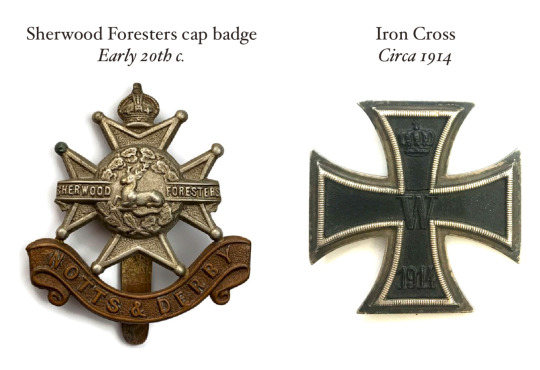
My uniform is also that of a British soldier (infantry, in my case) during the First World War. I won’t go through the ins and out of the entire uniform, but let’s take a look at the pfp so we can help you to better identify it in the future because another piece of context that can be gathered about my cap badge is from my uniform which would allow you to infer I’m not wearing a German badge because under no circumstances, especially during WW1, would you ever catch a British uniformed soldier sporting an Iron Cross on his cap.
In my pfp, I’m not even wearing all the correct things because it really was just a cheeky selfie I took some time ago with some modern items to replace what I didn’t have at the time lol. But let’s assume for a minute I’ve actually got full kit. It was meant to be winter, 1917. I’m also wearing my gas mask bag backwards for some reason (I also don’t have it secured).

Firstly, my standard dress (SD) British uniform and greatcoat—latter in spirit—is thick khaki wool. Germans, at least for the times you’re thinking of, wore at lot more blue/slate, grey, and black, with some occasional touch of colour trim like red. Many militaries wore green and brown during this time, the British were amongst them. The “Greatcoat” I’m wearing is at-a-glance-similar to one worn at the time by enlisted men. Gloves and scarves would ordinarily be knit (I had modern ones).
The trench cap is much like a standard peaked cap you might’ve seen in various other occupations and is very much like the khaki stiff cap normally issued only this one was meant to be softer and foldable, able to be stowed away in your pack as space was limited: you carried all your belongings with you wherever you went! It also had a chin strap no one ever realistically wore. While it depends on the year, these caps were usually worn when not on the front line as metal helmets were mandatory instead to protect from the falling debris and other projectiles.
Further down, I have my gas mask and small box respirator (SBR) which wasn’t widely used until 1917. Before this came the PH Hood or Gas Hood which was akin to basically a canvas pillowcase treated with a chemical compound through which you would breathe and featured a couple of glass eyeholes and a goofy looking rubber flap nearer the mouth to exhale. Before this, it was a chemically soaked rag or face cloth, sometimes it was soaked in your own piss as Urea (found in urine) was a natural deterrent for early chemical weapons. As things like mustard gas came more into use, old protections were no longer effective. The SBR was created as it used an internal wire and cotton filter also containing charcoal and soda/quicklime in a small metal box and was housed in a khaki canvas bag worn round the neck; air would pass through the better equipped filter, through the tube, and into a mouth piece making it safer to breathe.
Though not fully able to be seen, I’m also wearing Pattern 1908 canvas webbing. This held…pretty much everything. The whole thing comes apart to be just a belt but can be built up to carry about 150 rounds of .303 ammunition in those small front pockets, a sheathed bayonet and entrenching-tool wooden handle on the left, water bottle on the right, entrenching tool spade (for the handle) on the back or right, and a small or large pack worn on the back to hold extra clothes, hygiene items, kit maintenance supplies, personal items, and any other gear depending on the situation. The webbing was to be covered in a protective layer whose brand name was Blanco which gave the webbing that slightly green tinge and was essentially used to keep the canvas from rotting (today it still takes over 4 hours to put one coat on the whole thing with a small stiff brush, it’s gruelling)
While this certainly isn’t everything, I would hope it would slightly better inform you next time you encounter a British WW1 uniform as to not mistake it for a German WW2 uniform. Bit of an older reference, but below is a loose snapshot of what German infantry uniforms looked like progressing between 1914-1918 as to tell them apart from the ones during WW2.

As far as reenacting goes, not everyone who wears the kind of insignia you misidentified is going to be doing SS or partaking in dangerous ideologies. Germany existed before WW2, Germany famously went through WW1 long before the new Chanel designed uniforms were ever associated with industrialised fascism. I won’t speak for anyone who does any sort of German reenactment as that’s not my place since I don’t dress in that impression, but there is an unspoken code of conduct when you’re in any uniform as a reenactor: your first job is to be a living history educator and certain periods are still Hot, as in, even though the event might’ve ended, the aftermath still has an active impact on current society. It’s your job as a reenactor to be aware and conscious of the effects your visual presence has on a modern audience and take responsibility in wearing it mindfully and carefully as the hobby does not exist in a vacuum. I’m not saying there aren’t people in it to just “play bigot” because there definitely are people who do. But knowing who is and who isn’t largely begins with comprehension, at least loosely, of what you’re looking at. While no one expects you to be an expert, young people especially would benefit from knowing more history and multidimensional social and cultural related knowledge to provide further situational context when encountering these symbols, uniforms, and history. Things like this can help you tell the difference between a history nerd reenacting a British WW1 soldier and someone you think is lusting after a man with a very infamous moustache. Being able to distinguish one thing from another is unsurprisingly really helpful when or if you ever encounter these symbols or content outside of a reenactment setting and can indeed allow you to spot the true unsavoury people even in civvies, no uniform or iron cross required. I understand why you would initially react with fear upon seeing something you thought looked like a symbol which today can serve as a dog whistle for something darker, but learning context is key.
Furthermore I’m not sure how I could provide context to a pfp, other than having maybe say a WW1 signaller as my header image, my pinned post being WW1 related, and pretty much all personal content posted to this blog being about WW1 for over the last 8 years.
Hope this helps!
#plenty of YouTube videos on the progression of both uniforms as well#knowledge is power lads#lovely afternoon infodumping#asks#history#wwi
351 notes
·
View notes
Text

Paris Élégant, 1916
#Paris Élégant#1916#1910s#ww1#ww1 history#ww1 art#ww1 dress#ww1 fashion#Fashion#Fashionplate#Fashion sketch#Fashion illustration#Fashion history#Historical fashion#Historical clothing#Dress history#Vintage dress#Vintage fashion#Antique dress#Antique fashion#Antique clothing#Corset#Costuming#Costumes#Costume design#20th century#20th century art#20th century dress#20th century fashion#Turn of the century
12 notes
·
View notes
Text
A thing they don't tell you about drag (aside from how physically taxing it is) is that the adrenaline does most of the work. Can I do a handstand into a back bend normally? No. Can I do it spontaneously in front of 60 people in a tie and fishnets? Apparently yes.
Another successful night of being a drag king
#this extends to my death drops (i've only ever done them performing#no rehearsal#and apparently dropping into a split in my 4 inch rhinestone heels while dressed like a WW1 soldier#something for everybody#my hypermobility finally loves me!
5 notes
·
View notes
Text
Hi guys and welcome to Addie’s research spiral into the gay moustache:
Moustaches have always been a symbol of masculinity, sexuality and social standing
Like legit dating back to the 1800s we had the whisker and beard movement which started pushing the idea that facial hair can be masculine and sophisticated and not just a sign of lacking in morality and uncleanliness like the victorians used to think and you can actually draw a direct line to men feeling threatened to the patriarchy in those times and the prevalence of facial hair- this assertion of dominance and masculinity being seen similarly in ww1 soldiers, where facial hair became the accepted norm then post ww1 it went out of style again then this cycle repeats again with most wars.
There is also within the later 1800s and early 1900s links to sexuality and rebellion because younger men not having a full beard and instead having clean shaven faces or moustaches was seen as a sign of rebellion against older generations , also the need for maintenance of this style made it viewed as effeminate
Someone put it as the moustache has always been tied with the three fs: fops, foreigners and fiends meaning it was perceived that men would need to be well groomed or gay, foreign (particularly from Latin countries) or lacking in morals and evil to have a moustache
Okay so the origin of the gay moustache aside from the connection to the well groomed element
So post stonewall riots the gay moustache became a real thing like one qoute I found that was funny was arnie kantrowitz saying it was a requirement in the gay community, you needed a a flannel shirt, mustache or beard, bomber jacket, jeans and boots. We were dressing like the blue-collar men that turned us on." And a lot of it stemmed from what was dubbed the Castro clone look
Okay so Freddie was not in fact the originator of the Castro clone look
The castro clone look basically took all the really masculine and macho staples and made it extremely gay
The look originally being inspired by the men of the Castro neighbourhood in San Francisco in the early 60s and THAT actually comes from the “greaser”/hood look inspired by the 50s Italian American men and Latinos who also their subculture was born from their stereotypes
The Castro clone look doesn’t have one distinct origin but its popularity was fuelled by gay artists like Tom of Finland, and musicians like the village people and Freddie and gay pornstars like al Parker
And Parker was one of the big names in the Castro clone look this in particular not only explains the reason for his look well but also peep the “pouring beers over eachother” line and let me take you back to bachelor party buddie


And now I hear the republican man and Gerrard mentions and to that I say that’s the whole point of it
Like the hypermasculinised look was meant to not only play the macho aesthetic and be a form of queer signaling but it was also meant to subvert gay men stereotypes by instead doing this like extreme portrayal of masculinity
It’s drawing from straight men but making it’s undeniably queer
Like wife beaters, moustaches, denims and flannels were so tied to het males that they took that and still found a way to make it so undeniably queer that it became a form of queer signaling
Thus taking the power away from the macho hets and forming a new subculture
The gay moustache only started seeing its end around the 80s AIDS epidemic because the moustache aimed to make a person look older but as queer communities became more sick or perceived as unclean or sick the need to look clean and young grew and clean shaved faces became the trend again
So Eddie having the moustache isn’t some tie to Gerrard or straight people it’s actually so queer coded and a form of rebellion
And btw this isn’t even a niche thing it’s like a widely known queer thing to the point that one show got slammed for having a gay club scene set in that time and not having any Castro clones in it
178 notes
·
View notes
Note
Do you think Krueger would tie up and kidnap nikto to dress him up 😚
I mean… that’s one hell of a thought and I LOVE it. But realistically… probably not.
In my hc, they are not really into dressing up, using toys, role-playing, etc. during sex. They are pretty straightforward and have their sick ass fucking kinks, but it is always very organic to them.
Nikto in particular would not react kindly to being restrained due to his past. Krueger might hold him down sometimes when he is in an episode or has night terrors, but in general, he doesn’t do that much. It only leads to arguments and no one of them is better for it. Krueger things which are fun/interesting to him and this is just something which isn’t. He doesn’t get a kick out of it since he understands why Nikto is pissed off and it’s just a touchy subject…
But if he were to dress him up, it would be the result of them joking around. Like.: “Oh, I bet you would look like a mobster in a suit.” // “Yeah, sure, you make a flight suit work, but that’s easy. Try looking hot in spandex..” part good natured humiliation, part whimsy. If he could dress him up in a sexual way, it would happen because they saw something that got them both hot and bothered. He would probably get off on Nikto in Russian WW1 / WW2 attire, which you can see here… The sex that follows would be unhinged. (It physically pains me to say this since I am really left wing but… Krueger would wear a ww2 uniform in that setting… you know… German ones… you know… the black ones… like… the ones with the REALLY horrible implications. Like… urgh ew (retches) those.) It would probably lead to some loose prisoner of war “role play” and a good beating.
All in all, I believe Krueger likes Nikto best when he either wears his gear or worn sweat pants and a wife beater. (You know those kinds of grey joggers that really show off the junk because the fabric is so thin due to repeated washing…)
Still, have this and let your imagination go WILD! What would Krueger dress Nikto up in??? Tell me in the comments because my interest is piqued (sorry for that cringe comment bait but I genuinely wanna know now)

#call of duty#krueger cod#krueger x nikto#nikto x krueger#nikto cod#cod krueger#sebastian krueger#sebastian krueger x nikto#call of duty krueger#cod nikto#answered asks#asks
76 notes
·
View notes
Text

WIP; Otto and his twin sister Brunhild in Pomeranian folk dress w/ golden apples. Block colours done.
#ottoway#ww1 fiction#german#original comic#pomeranian#folk dress#deutchland#german mythology#freja and frej#my art#wip#otto odinkirk#brunhild odinkirk#twins#twin brother and sister
9 notes
·
View notes